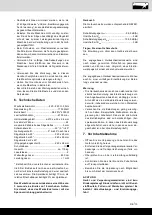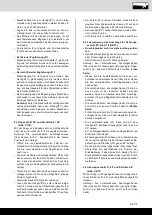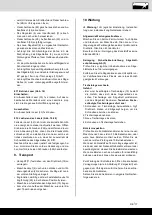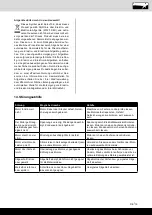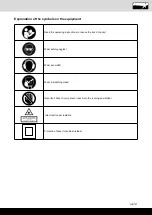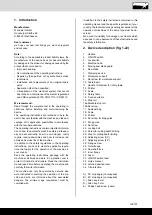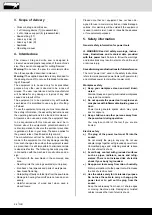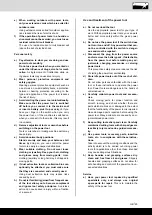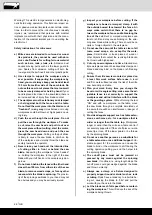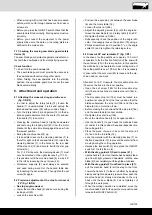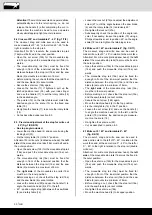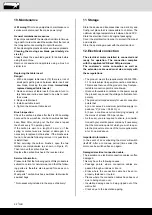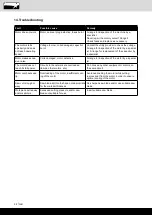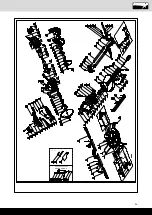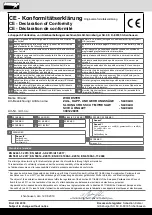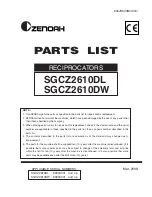
GB | 27
17 Prior to the use of insertion tools, make sure that
all protective devices are properly fastened.
18 Prior to use, make sure that the insertion tool
meets the technical requirements of this electric
tool and is properly fastened.
19 Only use the supplied saw blade for cutting wood,
never for the processing of metals.
20 Only use saw blade diameters in accordance with
the markings on the saw.
21 Use additional workpiece supports, if required for
workpiece stability.
22 Workpiece support extensions must always be
secured and used during work.
23 Replace table inserts when worn!
24 Avoid overheating of the saw teeth.
25 When sawing plastic, avoid melting of the plastic.
Use the appropriate saw blades for this purpose.
Replace damaged or worn saw blades immedi-
ately.
When the saw blade overheats, stop the machine.
Allow the saw blade to cool down before using the
machine again.
Attention: Laser radiation
Do not stare into the beam
Class 2 laser
Protect yourself and you environment from ac-
cidents using suitable precautionary measures!
• Do not look directly into the laser beam with un-
protected eyes.
• Never look into the path of the beam.
•
Never point the laser beam towards reflecting sur
-
faces and persons or animals. Even a laser beam
with a low output can cause damage to the eyes.
•
Caution - methods other than those specified here
can result in dangerous radiation exposure.
• Never open the laser module. Unexpected expo-
sure to the beam can occur.
• If you do not use the device for a long time, the bat-
teries should be removed.
•
The laser may not be replaced with a different type
of laser.
• Repairs of the laser may only be carried out by the
laser manufacturer or an authorised representative.
Residual risks
The machine has been built according to the state
of the art and the recognised technical safety re-
quirements. However, individual residual risks
can arise during operation.
• Health hazard due to electrical power, with the use
of improper electrical connection cables.
q) If the workpiece or blade becomes jammed,
turn the mitre saw off. Wait for all moving
parts to stop and disconnect the plug from the
power source and/or remove the battery pack.
Then work to free the jammed material.
Contin-
ued sawing with a jammed workpiece could cause
loss of control or damage to the mitre saw.
r)
After finishing the cut, release the switch, hold
the saw head down and wait for the blade to
stop before removing the cut-off piece.
Reach-
ing with your hand near the coasting blade is dan-
gerous.
s)
Hold the handle firmly when making an incom
-
plete cut or when releasing the switch before
the saw head is completely in the down posi-
tion.
The braking action of the saw may cause the
saw head to be suddenly pulled downward, caus-
ing a risk of injury.
Safety Instructions for the handling of saw blades
1 Do not use damaged or deformed saw blades.
2 Do not use any insertion tools with cracks. Sort out
cracked insertion tools. Repairs are not permitted.
3 Do not use saw blades made of high speed steel.
4 Check the condition of the saw blades before us-
ing the crosscut, drag and mitre saw.
5 Make sure that a suitable saw blade for the mate-
rial to be cut is selected.
6 Only use saw blades recommended by the manu-
facturer.
Saw blades designed to cut wood and similar ma-
terials must comply with EN 847-1.
7 Do not use saw blades made of high-speed alloy
steel (HSS steel).
8 Only use saw blades for which the maximum per-
missible speed is not lower than the maximum
spindle speed of the crosscut, drag and mitre saw
and which are suitable for the material to be cut.
9 Observe the saw blade direction of rotation.
10 Only insertion the saw blade if you have mastered
their use.
11 Observe the maximum speed. The maximum
speed specified on the insertion tool may not be
exceeded. If specified, observe the speed range.
12
Clean grease, oil and water off of the clamping
surfaces.
13 Do not use any loose reducing rings or bushes for
the reducing of holes on saw blades.
14
Make sure that fixed reducer rings for securing the
insertion tool have the same diameter and have
at least 1/3 of the cutting diameter.
15
Make sure that fixed reducer rings are parallel to
each other.
16 Handle insertion tool with caution. They are ideally
stored in the originally package or special contain-
ers. Wear protective gloves in order to improve
grip and to further reduce the risk of injury.
Содержание SL90LXU
Страница 4: ...4 21 22 17 20 E E E 19 32 32a 32b 32b 16 17 18 15 5 29 34 31 33 30 28 C 6...
Страница 20: ...20 DE...
Страница 35: ...35...

